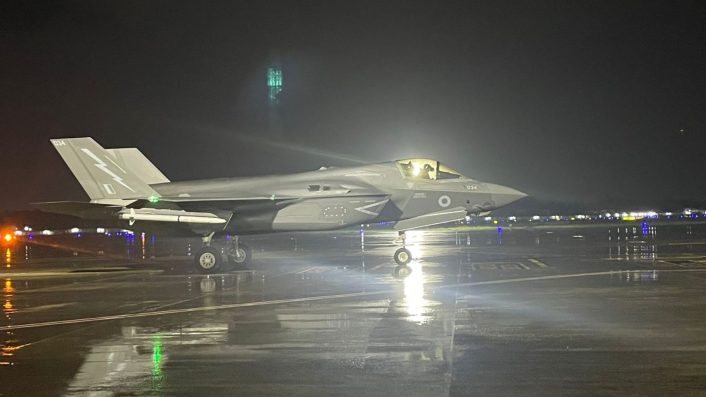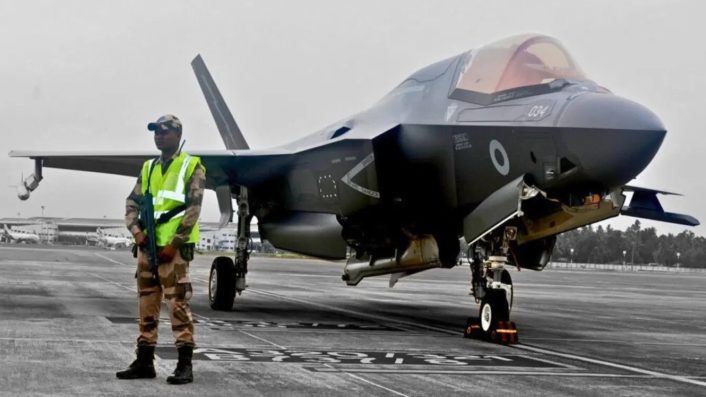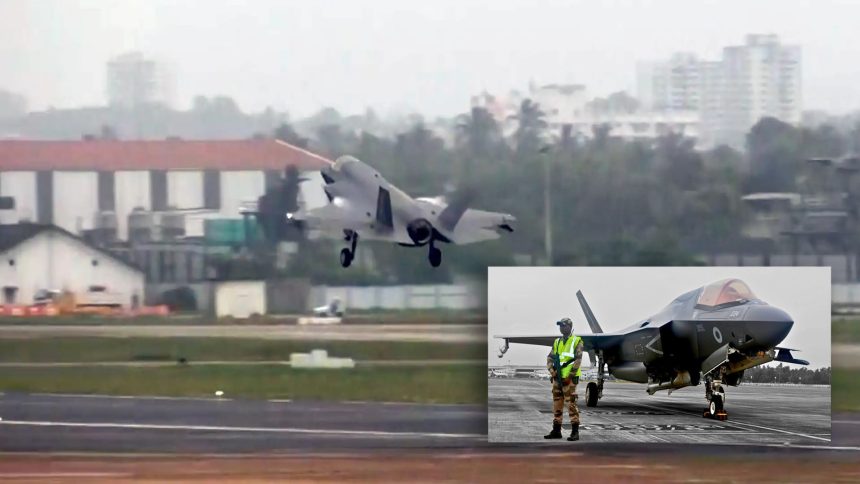38 days after an emergency landing in India, the repaired F-35B has taken off again, reportedly enroute to join HMS Prince of Wales.
The British F-35B from the HMS Prince of Wales aircraft carrier which was stranded at Thiruvananthapuram airport, in India’s southern state of Kerala, finally took off again on July 22, 2025. The aircraft has been grounded there since Jun. 14, 2025, reportedly after bad weather that prevented a safe landing on the carrier and later developing a hydraulic snag.
A 14-member engineering team arrived from the UK on Jul. 7 aboard an RAF A400M, after personnel from the RN’s flagship carrier could not address the issue. A visual released by ANI showed the cargo aircraft departing Thiruvananthapuram the same day.
After 38 days on ground, @RoyalNavy F-35 finally takes off. Farewell & happy landings! pic.twitter.com/8XmuzKoiuN
— Shiv Aroor (@ShivAroor) July 22, 2025
A day earlier, BBC quoted airport officials saying that “the aircraft is confirmed to be airworthy.” Deccan Herald quoted another official in deep background who said “It is being brought out of the hangar now. The jet will be brought to our bay, and it will fly back on Tuesday.”
According to unconfirmed reports, the aircraft might be enroute back to the UK, while others, citing airport sources, mention the jet it’s on its way to join again the carrier air wing. The HMS Prince of Wales is currently training with the U.S. and Australian navies during Exercise Talisman Sabre 25 in Australia.
Indian media published a statement from a spokesperson for the British High Commission:
“A UK F-35B aircraft, which landed following an emergency diversion on June 14, departed today from Thiruvananthapuram International Airport. A UK engineering team, deployed since July 06 completed the repairs and safety checks, allowing the aircraft to resume active service.
The UK remains very grateful for the support and collaboration of the Indian authorities and airport teams throughout the repair and recovery process.”
BREAKING ⚠️
A @RoyalNavy F-35B made an emergency landing this morning at the Thiruvananthapuram airport. The F-35 is from the HMS Prince of Wales aircraft carrier that’s in the Arabian Sea on deployment. (Photo/@the_hindu) pic.twitter.com/tSYxh80EbI
— Shiv Aroor (@ShivAroor) June 15, 2025
Previously there has been speculation that the aircraft would have had to be dismantled and transported back to the UK aboard a C-17 Globemaster III.
The aircraft carrier sailed from Britain in April for the Carrier Strike Group 25 (CSG25) deployment, designated Operation Highmast. The Carrier Air Wing aboard HMS Prince of Wales hosts 24 F-35Bs both from the Royal Navy and the Royal Air Force, as is the practice between the two services to jointly operate their Lightning IIs.
The aircraft belong to the 617 Squadron and 809 NAS (Naval Air Squadron). The F-35B grounded in India bears the modex 034 and serial ZM168, which identifies it as one of the aircraft assigned to the RAF’s 617 Squadron “Dambusters.”
UPDATE: A team of UK engineers has arrived in India to commence repairs on the UK F35B aircraft. Repairs are underway on the aircraft, which has now been moved to the maintenance hangar. We are grateful for the continued support and collaboration of the Indian authorities. 🇬🇧🤝🇮🇳 pic.twitter.com/WD0pmkiLNH
— UK Defence in India🇬🇧🇮🇳 (@UKDefenceIndia) July 7, 2025
Royal Air Force F-35B in India
The F-35B was conducting a routine flight outside India’s Air Defence Identification Zone (ADIZ) when it declared an emergency reportedly due to adverse weather conditions which prevented a landing on the carrier. The choice of Thiruvananthapuram airport is not casual as it was already earmarked as the emergency recovery airfield during recent joint exercises with the Indian Navy.
The jet initially coordinated with the IAF’s Integrated Air Command and Control System (IACCS) seeking permission for an emergency landing. The IAF, after granting approval, transferred the guidance to the Thiruvananthapuram ATC (Air Traffic Control). It is unclear when the jet developed the hydraulic issue that kept it on the ground.

In the little over a month that the STOVL (Short Take-Off Vertical Landing)-capable Lightning II has been in India, the aircraft, still carrying an ASRAAM (Advanced Short-Range Air-to-Air Missile) on its right wing, was parked in the open under surveillance by the Indian military. The first team from the Royal Navy, brought in by a Merlin Mk 4 helicopter, could not repair the aircraft. Meanwhile, security reasons were cited for not moving the F-35B inside the hangars.
Reports quoted a statement by the British High Commission on Jun. 26, 2025, stating that the aircraft would be moved to a Maintenance Repair Overhaul (MRO) hangar ahead of the arrival of the 14-member team in the A400M on Jul. 7. NDTV recently reported that the jet was finally relocated to a hangar on Jul. 6.
🔴#BREAKING | #Watch: UK F-35 jet, stranded in Kerala, out of hangar; Jet to leave India on Tuesday
📹: ANI/X pic.twitter.com/tJ5kYTq2CG
— NDTV (@ndtv) July 21, 2025
It is being reported that the Airports Authority of India (AAI) would also charge the UK parking fees for the jet, in the range of Rs 15,000 and Rs 20,000 a day (128 GBP to 171 GBP), as per The Indian Express. This also includes landing fees for both the F-35B and the A400M, pegged in the range of Rs 1 lakh and Rs 2 lakh (859-1,718 GBP). “Air India will fix the fee for using their Maintenance, Repair and Overhaul (MRO) facility at the airport,” an official told TIE.
Technical snag
There are conflicting reports on whether the adverse weather and low fuel preceded the hydraulic failure, or the other way round. Local media suggested that bad weather was the reason as the monsoon season has come early, with sudden squalls that bring strong winds, heavy rain and, sometimes, even thunderstorms.
While the F-35B is an all-weather day and night capable fighter, landing on an aircraft carrier can only be done within precise weather limits to ensure safety. This is especially true for the F-35B which has to perform a vertical landing when recovering on the carrier, as it would be even more affected by the strong winds and poor weather in general.
UPDATE: Following completion of repairs and safety checks, the UK F-35B aircraft today departed from Thiruvananthapuram International Airport, resuming active service. We are grateful for all the support from the Indian authorities 🇬🇧🤝🇮🇳 pic.twitter.com/4yMJzwkD6w
— UK Defence in India🇬🇧🇮🇳 (@UKDefenceIndia) July 22, 2025
Regarding the hydraulic problem, the hydraulic system of the F-35 is an evolution compared to older types, focused on survivability and ease of maintainability thanks to the use of new technologies such as Electro-Hydrostatic Actuators. However, some systems – such as the roll control nozzles in STOVL mode – still need “traditional” hydraulic systems to work.
It is unclear which type of hydraulic problem was found on the jet. However, it is possible that it affected the safety of flight or prevented the landing back on the carrier.
Previously, the CSG21 led by HMS Queen Elizabeth witnessed an F-35B crash in the Mediterranean Sea on Nov. 17, 2021. The jet, with open lift fan door and nozzle pivoted downward, rolled down the ski jump at very low speed (much lower than normal), before literally falling off the carrier for lack of enough thrust/lift.
The pilot ejected safely and the wreckage was later recovered with the support of Italy and the United States. In an exclusive story published by The Sun on Nov. 23, 2021, the cause was identified as a red plastic rain cover, which was supposed to be removed before flight.

UK and India
While India and the UK do not have robust defense ties, their strategic partnership has been on the upswing over the last few years. They have held exercises like the biennial Ajeya Warrior army drills, with the latest iteration taking place in 2023 on the Salisbury Plain in the UK, the Indradhanush air force drills and the Konkan naval exercises.
British Airforce A-400M left the Kerala Airport after leaving technical team for repair of F-35B.
One of perfect choice for IAF MTA Program as Tata is already making C-295 in India.
— Vivek Singh (@VivekSi85847001) July 6, 2025
After CSG25 entered the IOR (Indian Ocean Region), the carrier also conducted a PASSEX (Passage Exercise) with the Indian Navy in the western Arabian Sea, marking its “first major engagement” in this part of the world. Additionally, New Delhi sees London as an extension of the Western alliance including the US, France and Japan it maintains ties with, while balancing its far deeper, older and traditional strategic ties with Russia.
#INSTabar with submarine and P8I aircraft of #IndianNavy participated in a Passage Exercise in the North Arabian Sea on 09 and 10 Jun 25 with HMS Prince of Wales and HMS Richmond from UK Carrier Strike Group @COMUKCSG.
The multi-faceted naval exercise included unified control of… pic.twitter.com/DUUt8KikL0
— SpokespersonNavy (@indiannavy) June 11, 2025
This is one reason Indian diplomats unofficially cite for not considering the F-35 for its air force. The attendant obligations to align the country’s foreign policy with the U.S. upon purchase of major capital systems, would hurt its relationship with Russia. This is beside the high cost and logistical constraints that IAF chief Air Chief Marshal AP Singh has often implied while explicitly denying any interest in the fifth generation jet.









